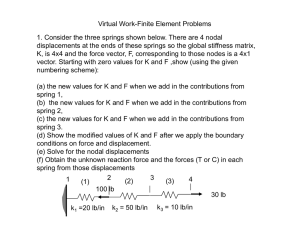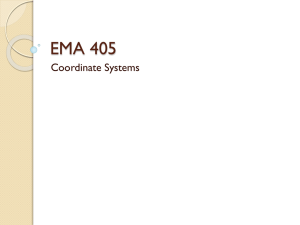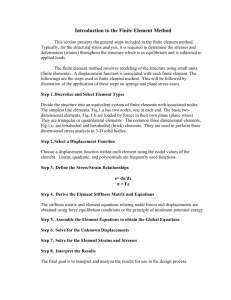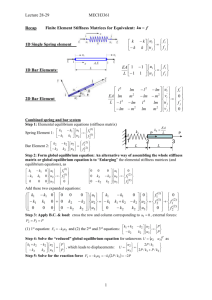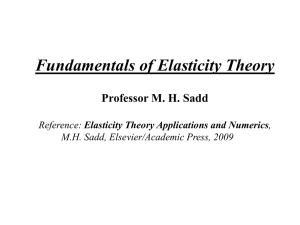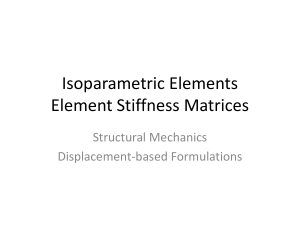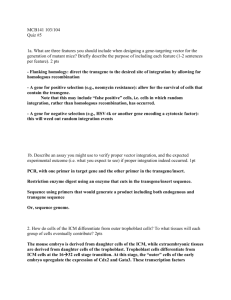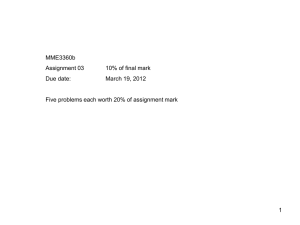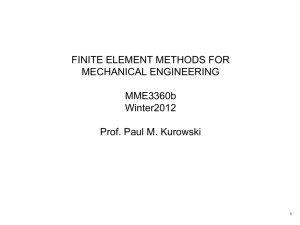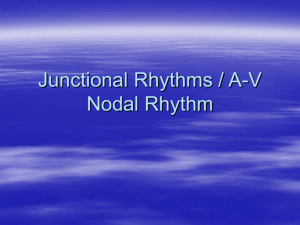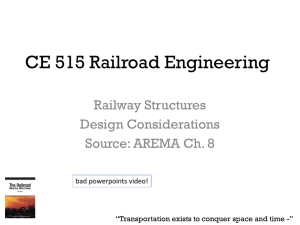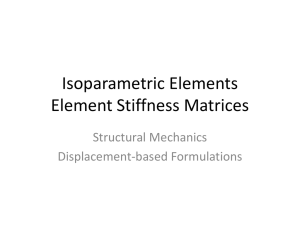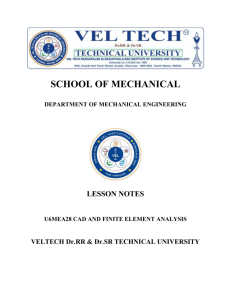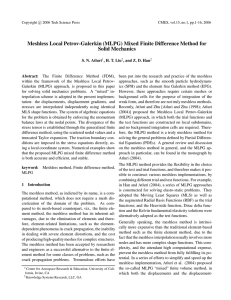strains and stresses
advertisement
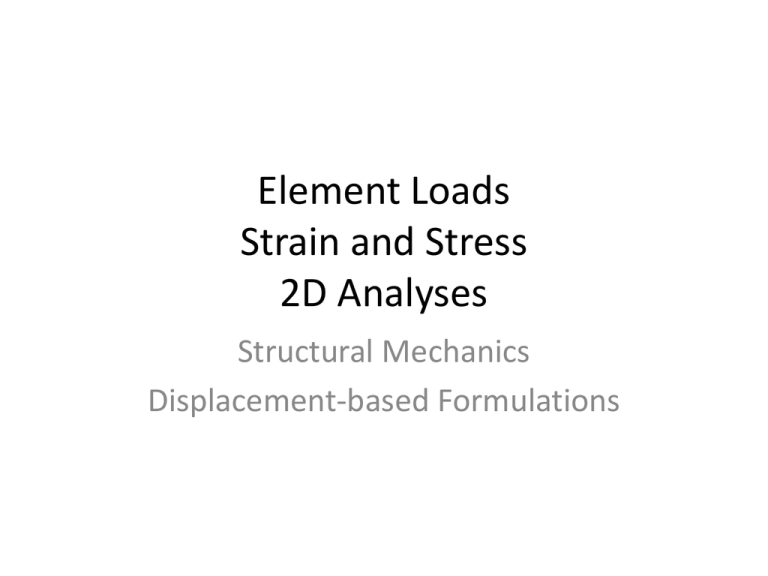
Element Loads
Strain and Stress
2D Analyses
Structural Mechanics
Displacement-based Formulations
Computational Procedure
• Element Matrices:
– Generate characteristic matrices that describe element behavior
• Assembly:
– Generate the structure matrix by connecting elements together
• Boundary Conditions:
– Impose support conditions, nodes with known displacements
– Impose loading conditions, nodes with known forces
• Solution:
– Solve system of equations to determine unknown nodal displacements
• Gradients:
– Determine strains and stresses from the nodal displacements
Example B.C.’s
• Displacements are handled by moving the reaction influences to the right
hand side and creation of equations that directly reflect the condition
• Forces are simply added into the right hand side
No b.c.’s
N3
32426694.11 -7680008.00 -26666666.67
0.00
-7680008.00 10239972.56
0.00
0.00
-26666666.67
0.00 26666666.67
0.00
0.00
0.00
0.00 20000000.00
-5760027.44
7680008.00
0.00
0.00
7680008.00 -10239972.56
0.00 -20000000.00
32426694.11
-7680008.00
-7680008.00 10239972.56
0.00
0.00
0.00
0.00
0.00
0.00
7680008.00 -10239972.56
E2
E1
0.00
0.00
1.00
0.00
0.00
0.00
-5760027.44
7680008.00
7680008.00 -10239972.56
0.00
0.00
0.00 -20000000.00
5760027.44 -7680008.00
-7680008.00 30239972.56
0.00
0.00
0.00
1.00
0.00
0.00
u1
v1
u2
v2
u3
v3
0.00
7680008.00
0.00 -10239972.56
0.00
0.00
0.00
0.00
1.00
0.00
0.00 30239972.56
u1
v1
u2
v2
u3
v3
=
=
- or -
N2
N1
E3
32426694.11
-7680008.00
7680008.00
-7680008.00
10239972.56
-10239972.56
7680008.00
-10239972.56
30239972.56
u1
v1
v3
=
0
-1000
0
1000
This is it! Solve for the nodal displacements …
F1x
F1y
F2x
F2y
F3x
F3y
0.00
-1000
0.00
0.00
0.00
0.00
Other Loading Conditions
• Consider the assembled equation system [K] {D} = {F}
• The only things we can manipulate are:
– Terms of the stiffness matrix (element stiffness, connectivity)
– The unknown or specified nodal displacement components
– The applied nodal force components
• How do we manage “element” loads?
– Self-weight, structural systems where gravity loads are significant
– Distributed applied loads, axial, torsional, bending, pressure, etc.
Conversion to Nodal Loads
• All loads must be converted to nodal loads
• This is more difficult than it appears
• It is a place where FEA can go wrong and give you
bad results
• It has consequences for strain and stress calculation
q (N/m)
L
F=?
F=?
• You might guess F = qL/2, but why?
ddist
L
0
dconc
P (x)dx
1 L
qL2
qxdx
EA
EA 0
2EA
PL FL
EA EA
• Setting dconc = ddist:
F
qL
2
Consistent Nodal Loads
• Consistent nodal loading:
– Utilizes the same shape (interpolation) functions (more
later) as displacement shape functions for the element
– The bar (truss) shape functions specify linear displacement
variation between the nodes
– We choose a concentrated nodal force that results in an
equivalent nodal displacement to the distributed force
• Question: Are element strain and stress equivalent?
No
sx
x
sx
x
Strain and Stress Calculation
• For bar/truss elements with just nodal boundary conditions:
– Find axial elongation DL from differences in node displacements
– Find axial strain e from the normal strain definition
– Find axial stress sfrom the stress-strain relationship
• Even when models become more complicated (higher order
displacement/strain relationship, complex constitutive model)
this is the general approach
DL from nodal displacements
DL
e
L
s Ee
Adjusting Strain and Stress
• Add analytically-derived fixed-displacement strain and stress
• This must be done for thermally-induced distributed loading
sx
x
sx
+
Note the added
constraint …
x
Mesh Refinement
• What if we model a bar (truss) or beam element not
as a single element, but as many elements?
• No gain is made in displacement prediction
– Holds true for node and element loading
• Strain and stress prediction improve
– Results converge toward the analytical solution even
without inclusion of “fixed-displacement analytical stress”
Piece-wise Interpolation
• If you remember nothing else about FEA, remember this …
sx
x
sx
These are not always flat …
2D/3D elements extend this
behavior dimensionally …
x
To Refine, or Not To Refine …
• It depends on the purpose of the analysis, the types
of elements involved, and what your FEA code does
• For bar (truss) and beam elements:
–
–
–
–
Am I after displacements, or strain/stress?
Does my FEA code include analytical strain/stress?
What results does my FEA code produce?
Can I just do my own post-processing?
• Always refine other element types
